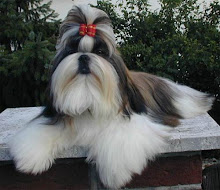The Shih Tzu dog breed survived a tragic history to become one of the most popular toy breeds around today. Shih Tzu historical information reveals that the breed has roots in royalty.
The Shih Tzu originated as the pampered pet of Tibetan Dowager Empress Tzu Hsi, who bred the dogs prolifically between 1861, when she came into power, and 1908, when she died. Her successor disdained the little dogs and everything they represented. As a result, many dogs were killed after the Empress’s death. Surviving Shih Tzus belonged mostly to foreigners and members of Chinese nobility, who had received the dogs as gifts from the Empress.
The breed first appeared in the United Kingdom during the late 1920s or early 1930s. North American soldiers who got to know the breed in Europe during World War II became fond of the little dogs and brought them back to the United States and Canada.
The Shih Tzu can be characterized as a lap dog with a pleasant personality and an eagerness to please the humans in its life. The dogs were bred for centuries to provide companionship, and they enjoy nothing more than lounging about in the company of humans. Their small size—nine to sixteen pounds—makes them a perfect pet for apartment dwellers and people who like to travel with their dogs.
Sometimes called “Tibetan lion dog,” Shih Tzus were bred to resemble lions, with a flat face, prominent eyes, bowed front legs, and a fearsome facial expression. The breed is also known as the “chrysanthemum dog,” because their wrinkled façade looks a bit like the chrysanthemum flower.
The Shih Tzu’s coat is long and slightly wavy and requires careful daily grooming to prevent mats and tangles. The results are worth the effort, as the dog’s silky coat enhances its elegant appearance.
The Shih Tzu breed has been recognized by the British Kennel Club since 1935 and by the American Kennel Club since 1969, and is a popular favorite at dog shows with its long, flowing coat. Shih Tzus show in the Toy Group, competing against dogs like the Maltese, the Pomeranian, and the Shih Tzu’s cousin, the Pekinese.
The breed is a good family dog, but its strong desire for attention from its master makes it a better choice for families with older children than families with infants. Some Shih Tzus have been known to develop problems with jealousy when living in a home with young children. However, most Shih Tzus are affectionate, friendly and outgoing, and are only to happy to play the role of valued family pet.
The Shih Tzu breed survived a dangerous period in the twentieth century to become the one of the twenty-first century’s most popular dog. The Shih Tzu is the ninth most popular registered breed in the American Kennel Club’s 2006 most popular breed list, and this little dog’s popularity continues to grow.
The Shih Tzu, or Tibetan Lion Dog, is small in stature, but a giant in personality. Its long hair requires diligent grooming, but this dog is well worth the effort. Breeders, libraries, and the Internet are all resources for more Shih Tzu information.
Subscribe to:
Post Comments (Atom)

No comments:
Post a Comment